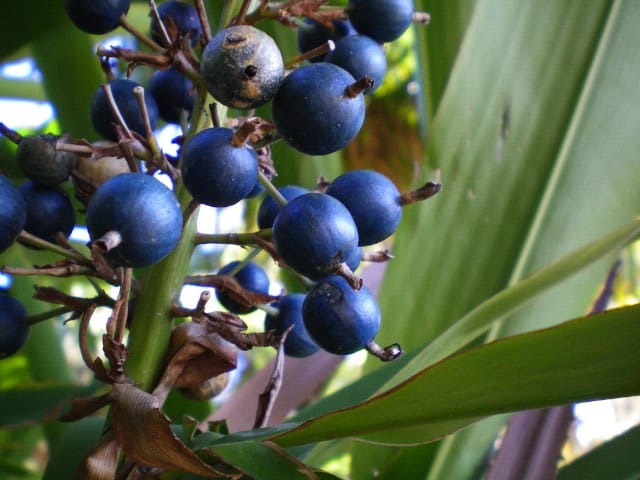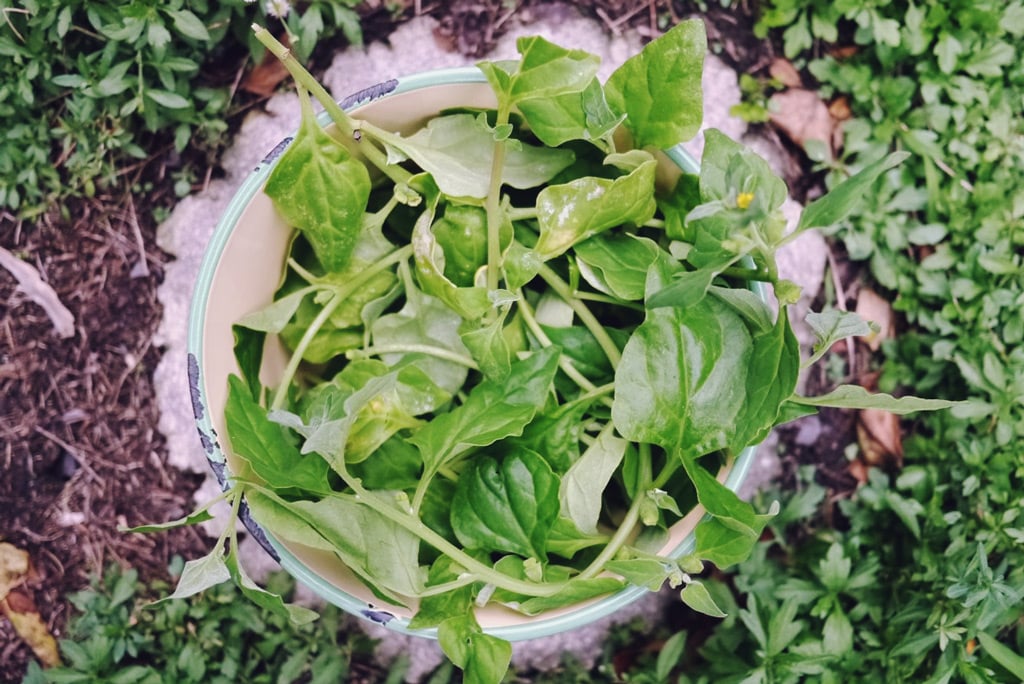
Planting some bush tucker plants is a great way to increase diversity and resilience. Here’s some tasty, compact suggestions for bush tucker gardening on the small.
The Australian continent is full of unique indigenous food plants that look and taste entirely unlike anything else you’ll typically see growing in an everyday edible urban garden, with its carrots and tomatoes and spinach.
Time to address that balance, wouldn’t you say?
And they don’t have to be big, either. While the many native edible tree crops such as quondong, illawarra plum, macadamia and small-leafed tamarind are a fine and tasty asset to larger gardens, if you’ve only got a little space, there’s still plenty to choose from to plant.
Finger Lime
The finger lime, Citrus australasica, has been called ‘lime caviar’ on account of the bead-like morsels of citrus-y goodness that the fruit contains.
It’s a small and thorny shrub, native to the rainforests on the border between NSW + QLD, which yields delicious limes coloured from pink to green, depending on the variety.
This is an understorey rainforest shrub, so consider that when you’re choosing it’s place in your garden, either under another, larger plant, or in a pot – dappled shade in an un-exposed nook will give the best harvest.
Native Ginger
Native Ginger, Alpinia caerulea, is another understorey rainforest plant – this one’s a herb, that grows up to a few meters high if allowed.
The blue berries are sour but delicious, and you can use them dried in teas. The young shoots are an excellent ginger alternative in cooking.
Warrigal Greens
Warrigal greens, Tetragonia tetragonioides, is also known as New Zealand Spinach, and Botany Bay Spinach.
It’s a delicious and hardy groundcover that grows from Victoria to Queensland from the beach up to the forest, and make a perfect edible living mulch underneath a potted citrus tree.
The leaves are edible and should be treated like silverbeet – they have some oxalic acid in them , so blanch before using. Warrigal greens works well in pots and vertical gardens, thanks to its hardiness and ability to adapt.
Native Rosella
Native Rosella, Hibiscus Sabdariffa, is technically from South Africa but now considered naturalised in Australia (please comment below if you know the story with that?).
We love this plant – it’s a shrubby bush, great for pots, that puts out yellow hibiscus flowers in Spring, followed by the delicious red flower calyx in late Autumn.
The whole plant is edible – shoots, leaves and roots, and the red calyxes make great jams and cordials, or are preserved whole in syrup.
Of course, this is just the beginning – there are hundreds of other bush tucker plants suitable for your small garden.
Blue Flax Lily
Blue flax lily, or dianella caerulea, is a hardy perennial bush perfect for poking in the dry corner of a bed or a pot.
It’s natural range is from Victoria to southern Queensland, and it puts up with a range of growing conditions.
The Blue Flax Lily flowers in Spring, followed by flushes of edible blue berries, which are sweet and delicious. You can use the leaves to make a sturdy fibre suitable for weaving also.
BUT! A word of caution – be careful not to confuse dianella caerulea with the similar-looking dianella tasmanica, which is said to be toxic. Here’s a bit more info on blue flax lily and how to tell different species apart.
Bush Tucker – good books + further resources
- Daleys Nursery has a great range of bush food plants
- The Australian Botanic Gardens’ Bush Food bibliography
- Dark Emu – black seeds: agriculture or accident? – Bruce Pascoe
What native foods do you cultivate at your place? We’d love to hear…
We acknowledge that the successful historical stewardship of all the plants discussed above is due to the last many thousands of years in which Indigenous Australians practiced a type of agriculture that was far more regenerative than most other cultures to date, which has resulted in one of the longest continuous cultures of humanity. More…




















Love this. 🙂 I’ve recently begun foraging here in Queensland, and love learning about the native foods that grow around me. 🙂
there is so much to learn!
Thanks so much for another great article. I’ve got all of these except to Rosella. The great thing about natives is that they can be excellent marginal plants, growing where sun and nutrient hungry northeners refuse to grow. Warrigal greens are an excellent ground cover and will out-compete wandering tad given half a chance. Finger limes were once used to provide a fence around vegetable gardens to deter rabbits and roos so if you have either of these pests it might be worth a try. I’ve had no trouble growing it from a cutting. I also think the native Lemon… Read more »
thanks Meg! Will add Lemon Myrtle to the small-space list 🙂
Just a question… Woukd any grow in pots in my neck of the woods… Winnipeg, Manitoba, Canada
None of these will deal with frost or snow very well, but if you have a greenhouse or conservitorium, you could try?
Hi Elaine I live in the south of the south Island of NZ. What’s called Warrigal greens or NZ spinach grows wild in many places right through winter. It snows here though not long lasting and we have some good frosts all at sea level. It does however like to grow in acid conditions and often as a groundcover. So you could grow it in pots and maybe bring it in in winter or try them under eaves, shrubs or an outside roof.
Nice article. Are any of these so invasive that I should avoid them in USDA Zone 9b, with pH8?
None of them are invasive, but we don’t use US zoning so you’d need to describe in max/min temps and rainfall 🙂
Average High – 37C, Average Low – 5C,
Average annual rainfall – 280mm. We receive about 60% in a late summer season (“monsoon”), and the rest in winter.
Thanks
sounds like you would be suitable for some of the dryer inland bush tuckers like desert tomato and so on –
There’s also a hundred good nutritional reasons to eat more foraged wild foods apart from their amazing flavours. I have just released my new book, Wild Foods; Looking back 60,000 years for clues to our future survival. It might interest some of your visitors to discover how many diseases have an underlying nutritional cure.
So the 20 Million Trees grant is currently open and does include plantings for regenerative habitat for bird species and lots of other “key focuses” as part of the grant where native foods could be planted. I am hoping to have a broadscale planting of these here in SA in our region, but it sounds like you rockstar gardeners on the East Coast have a better array of deliciousness to play with and I hope someone is motivated and inspired to do something like a native bush food garden somewhere on a large scale… for birds… and humans of course!!… Read more »
Would love the finger limes … Lol… Ohh what the he k would love to grow all of the 5 in pots… Outside in sumner and inside in winter
Where would I get them from or can soneone slip me some slips… Lol
start at your local community garden and work out from there! http://communitygarden.org.au/
Or Daleys nursery, as noted in the article, sells them
If you want Rosella seeds green harvest has them for sale. they can be purchased at greenharvest.com.au. They might even have wrangle greens as well
I’d highly recommend Austromyrtus dulcis “Migim Berry” and Billardiera scandens “Apple Dumpling. Both are suitable for pots, courtyards, small gardens – and of course larger gardens! Ficus coronata can also be grown in a pot – I’ve had one for about five years. It fruits beautifully every year and thrives on neglect. The fruit this year was delicious! Also – Hibiscus heterophyllus, the Native Hibiscus (sometimes confusingly referred to as Native Rosella) can be grown in medium gardens, and may grow OK in a pot (I’ve not tried). The petals are edible, but the seed pods have awful hairs covering… Read more »
Thank you Lauren!
Has anyone had any issues with what might be red spider mite on a finger lime? I have lots of flowers but the leaves are disappearing quickly with these little devils.
i’d be interested to know of any staple foods / starches come from Australian natives. is there any native equivalent to potato or grains?
yes, lots. Murnong tubers, plenty of yams, and various varieties of cultivated grains + rice – https://www.milkwood.net/2015/09/25/new-book-dark-emu-rethinking-indigenous-australian-agriculture/
In my new book, Wild Foods; Looking back 60,000 years for clues to our future survival/ I also discuss why we should be eating our indigenous foods, I cover their nutritional values, some new crops and how to use any wild food you harvest and turn your meals into stunning restaurant-fare (or better). You can get the book at any good bookshop or order on-line at http://www.wildfoodscience.com
Finger limes are such an easy piece of bush tucker to grow in your garden! I have had mine growing for years, and have developed some really good information on growing them and using them over on my blog > http://bit.ly/1bcBo13
I’ve seen the Blue Flax Lily growing at the Singapore Botanic Gardens but had no idea it is native to Australia and that the blue berries are edible. Thanks for sharing this information.
ah how awesome! Enjoy, Susan 🙂
Love these five plants for your garden . This can help to design my fence
I believe when an introduced plant is considered “naturalised”, it means that the plant can suistain itself in the environment and reproduce, as opposed to going extinct. So that doesn’t mean that it is part of the ecosystem in a beneficial way, and that also means all non-native weeds would be considered naturalised, because they can certainly reproduce and thrive successfully in their new environment. It also doesn’t mean they are harmful though – think dingoes, which we’re technically introduced but now fill the ecological niche left by the thylacine on the mainland. According to tuckerbush.com.au Dianella revoluta was “Thought… Read more »